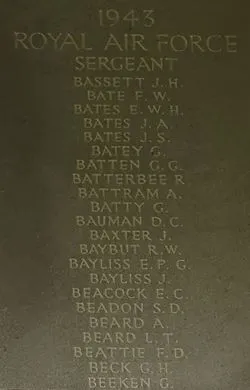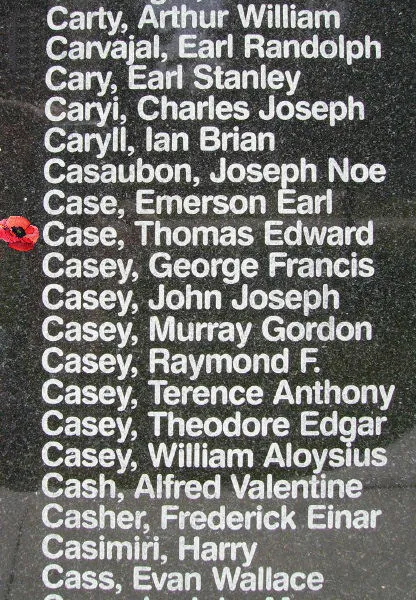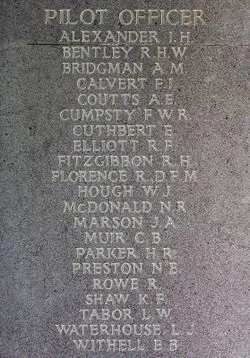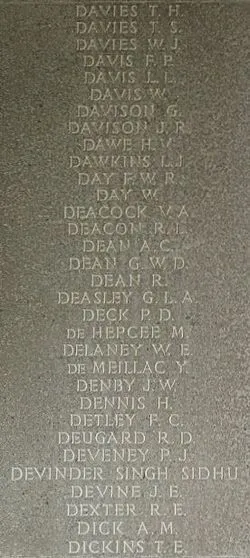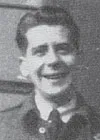DFM Citation: On one night in July 1942, 401243 Sergeant McLennan was the wireless operator of an aircraft detailed to attack Duisberg. When nearing the target area, the pilot was compelled to dive the aircraft violently, and Sergeant McLennan was thrown from his position in the astro-hatch. A box of incendiaries bombs broke loose from its stowage, and the contents were scattered in the rear of the aircraft. One of the bombs became ignited, setting a further one alight and filling the aircraft6 with sparks and smoke. With his bare hands Sergeant McLennan picked up one of the blazing bombs and endeavoured to throw it out through the escape hatch. He was unable to open the hatch but with great presence of mind, he pushed the burning bomb through the fabric of the fuselage. In spite of burns to his hands, he picked up the remaining bomb and disposed of it in a similar manner. By his prompt and courageous action, this airman averted an extremely serious situation
McLennan, Hugh Alexander (Pilot Officer)
Killed in Action 1943-February-19
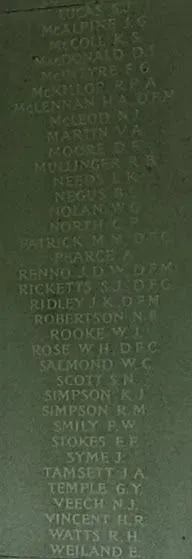

Birth Date: 1916-July-06
Born: Temora, Temora Shire, New South Wales, Australia
Parents: Son of Hugh Richmond McLennan and Merzine Anne Pauline (nee Kahlefeldt) McLennan, of Albury, New South Wales, Australia
Spouse:
Home: Albury, New South Wales, Australia
Enlistment: Melbourne, Australia
Enlistment Date: 1941-January-05
Decorations: DFM
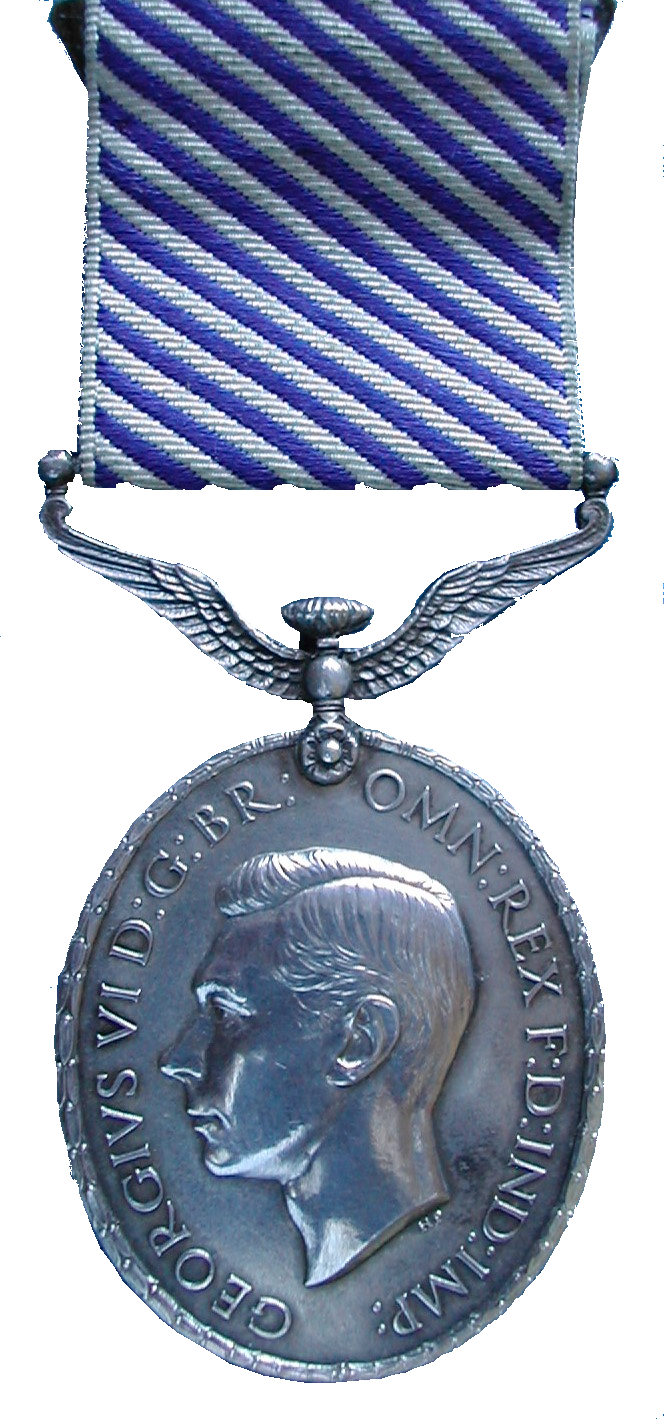
Service
RAAF
Unit
156 (PFF) Sqn- Squadron (RAF)
We Light The Way
Base
RAF Warboys
Rank
Pilot Officer
Position
Wireless Operator/Air Gunner
Service Numbers
401243
Crew or Other Personnel
Lancaster ED485
Mission
Lancaster Mk.I/III ED485
Bombing Wilhelmshaven Germany 1943-February-19 to 1943-February-19
156 (PFF) Sqn (RAF) RAF Warboys
156 Squadron (We Light The Way), Pathfinder Force, RAF Warboys. Lancaster BII aircraft ED 485 was lost without a trace during an operation over the naval yards at Wlihelmshaven, Germany. The Lancaster may have been shot down by night fighter pilot Oberleutnant Paul Gildner of the Stab IV/NJG-1, crashing into the North Sea, North of Vlieland, Friesland, Netherlands with the loss of the entire crew
Pilot Officer H W Welch (RCAF), Pilot Officer T E Case (RCAF), Pilot Officer P Y C Tremblay (RCAF), Pilot Officer E Cuthbert (RNZAF), Pilot Officer H A McLennan DFM (RAAF), Sergeant E P G Bayliss (RAFVR) and Sergeant J W Denby (RAFVR) were all missing, presumed killed in action
The missing have no known graves and all are commemorate d on the Runnymede Memorial
Several of the crew members of Lancaster ED 245 had been involved in the crash of 156 Squadron Wellington III aircraft X3811, which encountered icing conditions and was abandoned over England after a fire started
Flight Sergeant T E Case (RCAF) and Flight Sergeant H W Welch (RCAF) were slightly injured, Flight Sergeant P Y C Tremblay (RCAF), Sergeant H A McLennan (RAAF) and Sergeant E Cuthbert (RNZAF) survived, safe. However, the Wellington crashed into the village of Somersham, Huntingdon, England, where it destroyed several houses on High Street and killed 11 people on the ground: Pauline Margaret Cattanach, Vera Cattanach, Juliana Davies, Annie Maria Holdich, Alice Lamb, William Francis Lamb, Violet Ewing Moule, Eliza Nightingale, Elizabeth Richardson, Ena Joyce Stroud and Elsie May Taylor
Several of the crew members of Lancaster ED 245 had previously been involved in the crash of 156 Squadron Wellington III aircraft X3811, which encountered icing conditions and was abandoned over England
Flight Sergeant T E Case (RCAF) and Flight Sergeant H W Welch (RCAF) were slightly injured, Flight Sergeant P Y C Tremblay (RCAF), Sergeant H A McLennan (RAAF) and Sergeant E Cuthbert (RNZAF) survived, safe. However, the Wellington crashed into the village of Somersham, Huntingdon, England, where it destroyed several houses on High Street and killed 11 people on the ground: Pauline Margaret Cattanach, Vera Cattanach, Juliana Davies, Annie Maria Holdich, Alice Lamb, William Francis Lamb, Violet Ewing Moule, Eliza Nightingale, Elizabeth Richardson, Ena Joyce Stroud and Elsie May Taylor
![]() Royal Air Force Serial and Image Database
Royal Air Force Serial and Image Database
![]() Crash of an Avro 683 Lancaster I off Vlielandin: 7 killed I Bureau of...
Crash of an Avro 683 Lancaster I off Vlielandin: 7 killed I Bureau of...
Lancaster serial: ED485

Canadian Warplane Heritage Museum
The Avro Lancaster is a British Second World War heavy bomber. It was designed and manufactured by Avro as a contemporary of the Handley Page Halifax, both bombers having been developed to the same specification, as well as the Short Stirling, all three aircraft being four-engined heavy bombers adopted by the Royal Air Force (RAF) during the same wartime era.
The Lancaster has its origins in the twin-engine Avro Manchester which had been developed during the late 1930s in response to the Air Ministry Specification P.13/36 for a capable medium bomber for "world-wide use". Originally developed as an evolution of the Manchester (which had proved troublesome in service and was retired in 1942), the Lancaster was designed by Roy Chadwick and powered by four Rolls-Royce Merlins and in one version, Bristol Hercules engines. It first saw service with RAF Bomber Command in 1942 and as the strategic bombing offensive over Europe gathered momentum, it was the main aircraft for the night-time bombing campaigns that followed. As increasing numbers of the type were produced, it became the principal heavy bomber used by the RAF, the Royal Canadian Air Force (RCAF) and squadrons from other Commonwealth and European countries serving within the RAF, overshadowing the Halifax and Stirling. Wikipedia
